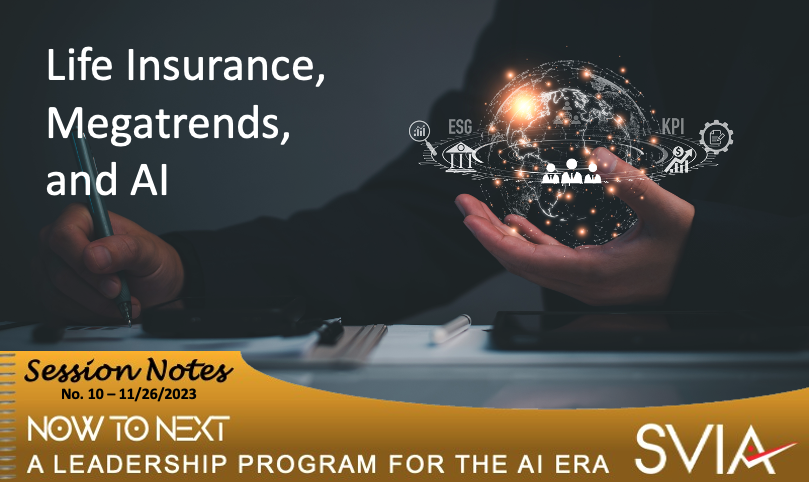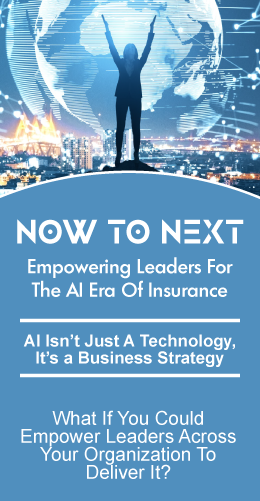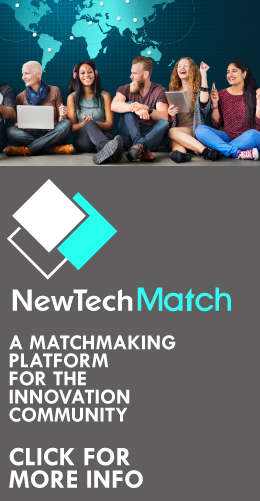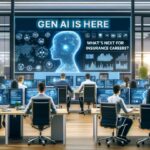
Global megatrends are not just reshaping the world at large; they’re fundamentally altering the insurance landscape. It’s a transformation driven by emerging technologies, climate, changing demographics, evolving consumer expectations, and a new focus on sustainability. As AI becomes increasingly central to this reshaped world, life insurance leaders face an urgent task. Strategically integrating AI to remain competitive and relevant.
The convergence of global megatrends with technological advancements like AI, ML, and blockchain creates unprecedented opportunities and challenges for insurers. From climate shifts and demographic changes to political and economic fluctuations, these trends demand a re-envisioning of insurance strategies. As customer expectations evolve towards more personalized, digital-first solutions and as health and wellness trends gain prominence, the industry must adapt. Executives who understand these shifts and prepare their companies to thrive with them will be in high demand in an AI-powered future.
Key Factors: Global Mega Trends Impacting Life Insurance
Climate Shifts: Beyond natural disasters, shifting weather patterns affect agriculture, food security, and livelihoods. Extreme weather conditions also influence public health, leading to new health risks and diseases. Insurers must adapt by recalibrating risk models to include these broader climate impacts, moving towards real-time, predictive solutions for a more comprehensive insurance offering.
Demographic Changes and Urbanization: Aging populations in developed regions are shifting focus towards asset protection and health coverage, while younger demographics in emerging markets prioritize flexible, experience-based insurance. Urbanization and the rise of smart cities provide rich data for hyper-personalized policies, catering to urban lifestyles and challenges.
Global Instability and Conflict: Increasing geopolitical tensions and armed conflicts create new risk landscapes. Insurers must navigate these complexities, factoring in the impact of conflict on global economies and individual security, leading to more nuanced underwriting and policy structuring.
Political Polarization: Deepening political divides can lead to regulatory uncertainties and shifts in policy, affecting areas like healthcare and retirement planning. Insurers must stay agile to adapt to rapidly changing political landscapes.
Economic Shifts: Recessionary pressures and the rise of the gig economy are reshaping consumer insurance needs. Insurers must offer flexible, adaptive policies to cater to these economic changes.
Pandemics: The global impact of pandemics like COVID-19 has highlighted the need for insurance products that address public health crises, changing travel habits, and the economic fallout from such events.
The Drive Toward Sustainability: The focus on sustainability pushes insurers to consider environmental risks more closely and offer products that align with green initiatives.
Technological Advancements: AI, blockchain, and IoT are not only enhancing operational efficiency but also enabling new ways of risk assessment and policy management, crucial in adapting to these global megatrends.
These factors collectively demand a strategic, AI, and data-driven approach, enabling insurers to respond to the evolving global landscape effectively.
A Future Forward Scenario: Swarm AI in Action at FutureInsure
Setting the Stage: Understanding Swarm AI
FutureInsure, a fictitious forward-thinking life insurance company, has embraced Swarm AI technology to navigate the complexities of the modern world. FutureInsure employs multiple specialized AI systems, each designed to perform specific tasks or analyze particular data types. These systems operate independently but are interconnected, allowing for seamless communication and data sharing.
The company partners with different providers for various AI systems, each specializing in a unique domain. For instance, one AI might specialize in analyzing demographic trends, another in environmental risk assessment, and yet another in financial market dynamics.
The company’s Product Development Head, Michael Chen, utilized Swarm AI to craft innovative wealth and health products. For the increasingly nomadic Digital Natives, they developed flexible, on-the-go insurance plans encompassing health, travel, and asset protection, adaptable to changing locations and lifestyles. For Boomers, now retiring and relocating, FutureInsure offers products focusing on wealth redistribution, property insurance in climate-stable areas, and comprehensive health plans.
John Lee, the Chief Strategy Officer, accessed insights aggregated by Swarm AI across departments. This AI, named ‘Athena’, integrated inputs from various department-specific AIs to give a holistic business outlook. Athena provided real-time impact assessments and strategic recommendations, enabling John to make informed decisions quickly.
During a sudden economic downturn, Athena alerted John about the likely increase in claims and a potential drop in new policy purchases. Simultaneously, it provided data-driven strategies to mitigate these effects, such as offering flexible premium options and ramping up digital marketing efforts targeting budget-conscious consumers.
AIs at FutureInsure aren’t just tools; they are intelligent, proactive partners. They assist human counterparts in navigating their jobs effectively, from developing tailored products to strategizing business responses to global changes.
Key Takeaways:
Embrace Comprehensive AI Strategies: The rapidly evolving insurance landscape, influenced by global megatrends such as climate shifts, demographic changes, and economic fluctuations, necessitates a holistic AI approach.
Understand the Impact of Megatrends: Recognize how trends like global instability, political polarization, and pandemics are reshaping customer needs and expectations. These trends should inform product development, risk assessment, and customer engagement strategies.
Adopt Swarm AI for Unified Insights: Swarm AI offers a way to aggregate and analyze data from multiple sources, providing a comprehensive view of risks and opportunities. It allows for more accurate, real-time decision-making across various insurance functions.
Develop Products for Evolving Demographics: Tailor products and services to address the specific needs of diverse groups, such as Digital Natives seeking flexibility and Boomers focusing on wealth redistribution and retirement planning.
Prioritize Personalization and Value-Added Services: Use AI to offer hyper-personalized products and services that go beyond traditional insurance coverage, aligning with modern lifestyle and wellness trends.
Strategically Navigate Political and Economic Changes: Utilize AI-driven tools to anticipate and adapt to political and economic shifts, ensuring agility and resilience in an unpredictable global environment.
Leverage AI for Sustainability Initiatives: Integrate sustainability into your business model by utilizing AI to predict environmental risks and promote sustainable behaviors.
View AI as a Collaborative Partner: AI should be seen not just as a tool but as a proactive partner that enhances the capabilities of human teams, driving efficiency and innovation.
Critical Questions:
- Are we proactively adjusting our business model to address the impacts of climate change, demographic shifts, and other global trends?
- Are we leveraging AI just as a tool for efficiency, or are we using it strategically to drive innovation and reshape our business?
- Do we have strategies in place to quickly adapt to regulatory changes, geopolitical tensions, and economic fluctuations?
- Are our products and services tailored to the unique needs of different demographic groups, such as Digital Natives and Boomers?
- Are we effectively harnessing data for predictive analytics, risk assessment, and personalized customer engagement?
- Have we identified and invested in AI and ML technologies that will drive the most value for our business and customers?
- Do we have robust policies for ethical AI use and data privacy that align with evolving regulations and customer expectations?
- What initiatives are in place for training and upskilling our workforce to leverage AI effectively?
- Are we considering environmental risks and sustainability as integral parts of our risk assessment and product development?
- How are we ensuring that our AI systems continuously learn and evolve to keep up with changing market demands and technological advancements?
Executive Actions: Aligning Strategy To Compete in the AI Era
Short-Term Actions:
Conduct an AI Readiness Assessment: Evaluate current AI capabilities, identifying gaps in technology, data infrastructure, and skills.
Initiate AI Literacy Programs: Launch educational initiatives to enhance AI understanding across the organization.
Develop a Flexible AI Integration Plan: Create a plan that allows for quick adaptation to emerging AI technologies and market changes.
Prioritize Data Privacy and AI Ethics: Implement policies and frameworks to address data privacy concerns and ethical AI use.
Launch Pilot AI Projects: Start with small-scale AI projects in critical areas like customer service or claims processing to demonstrate value and learn.
Long-Term Actions:
Build a Comprehensive AI Strategy: Develop a long-term strategy that aligns AI integration with broader business goals and global trends.
Invest in Advanced AI Technologies: Allocate resources for cutting-edge AI solutions like Swarm AI to stay ahead in the market.
Foster Partnerships for Innovation: Collaborate with tech firms, startups, and academic institutions to access new AI insights and developments.
Revise Products and Services: Continuously update insurance products and services to align with changing customer demographics and expectations.
Strengthen Global Market Awareness: Maintain a robust network to monitor and respond to global political, economic, and social changes.
Emphasize Sustainability and Social Responsibility: Integrate sustainable practices into business operations and product offerings.
Encourage a Culture of Continuous Improvement: Promote a culture that values innovation, experimentation, and adaptation in the face of AI evolution.
The era of AI and global mega trends presents both challenges and opportunities for the life insurance and group benefits sector. To stay competitive, executives must act decisively, leveraging AI strategically to adapt to these changes. The time for action is now; the future of life insurance is unfolding, and it is inherently intertwined with AI.







